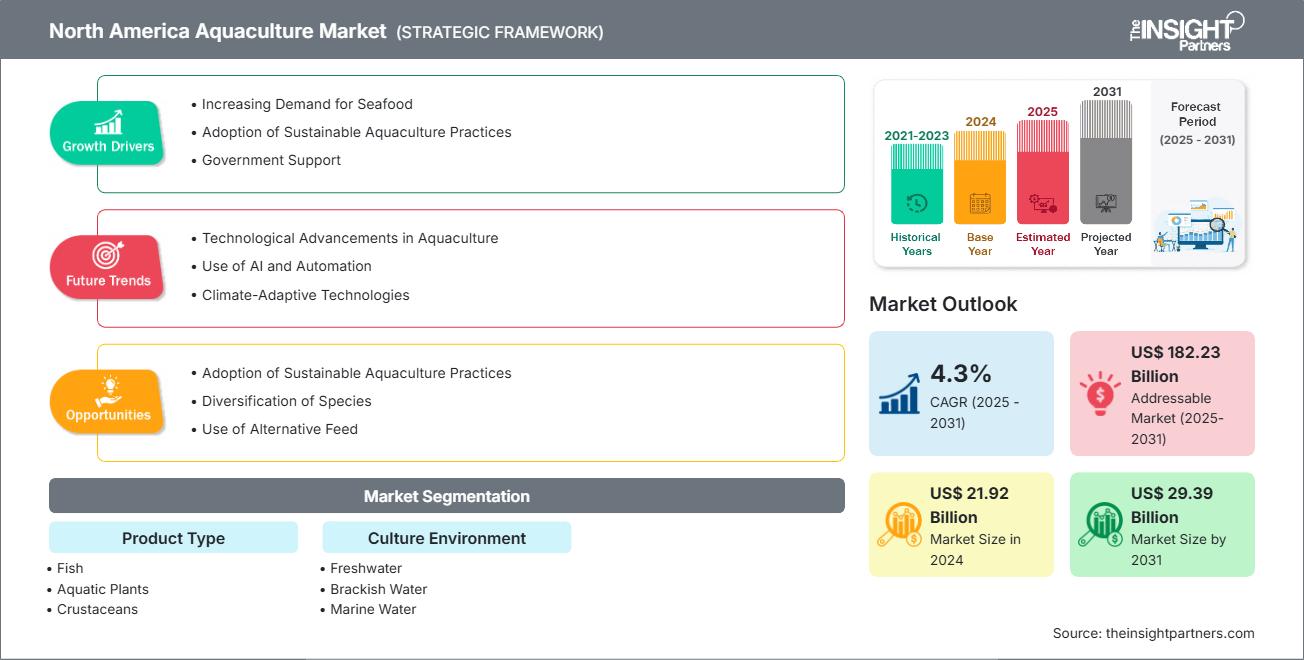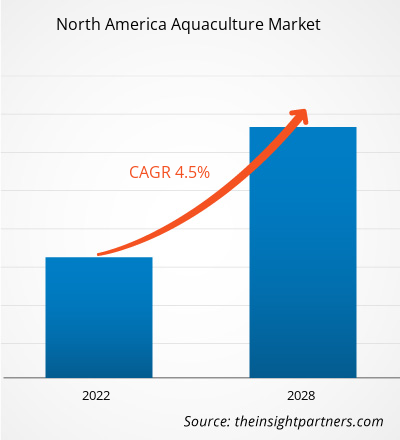The North America Aquaculture Market size is projected to reach US$ 29.39 billion by 2031 from US$ 21.92 billion in 2024. The market is expected to register a CAGR of 4.3% during 2025–2031.
North America Aquaculture Market Analysis
The North America aquaculture market is driven by rising demand for seafood, sustainable protein sources, and technological advancements in farming techniques. Increasing health awareness and depletion of wild fish stocks further fuel market growth. Opportunities lie in expanding recirculating aquaculture systems (RAS), precision aquaculture, and the cultivation of high-value species like salmon and shellfish. Supportive government policies, investment in R&D, and growing consumer preference for traceable and eco-friendly products present strong potential for industry expansion across the US, Canada, and Mexico.
North America Aquaculture Market Overview
North American countries, particularly the US and Canada, focus on enhancing domestic seafood production to reduce reliance on imports and meet rising protein demands. Innovations in feed, disease control, and recirculating aquaculture systems (RAS) are improving productivity and environmental performance. Regulatory support and consumer demand for locally farmed, traceable, and high-quality seafood further boost the industry. With ample coastline and investment in research, North America is poised to expand its role in the aquaculture sector.
Customize This Report To Suit Your Requirement
You will get customization on any report - free of charge - including parts of this report, or country-level analysis, Excel Data pack, as well as avail great offers and discounts for start-ups & universities
North America Aquaculture Market: Strategic Insights

-
Get Top Key Market Trends of this report.This FREE sample will include data analysis, ranging from market trends to estimates and forecasts.
North America Aquaculture Market Drivers and Opportunities
Market Drivers:
- Rising Seafood Demand A growing population and changing dietary preferences increase the need for seafood.
- Declining Wild Fish Stocks Overfishing reduces wild catches, pushing the need for farmed seafood.
- Technological Advances Innovations like automated feeding and water quality monitoring boost productivity.
- Health Awareness Consumers seek nutritious sources rich in omega-3 fatty acids, favoring aquaculture products.
- Supportive Government Policies Regulations and subsidies encourage sustainable aquaculture development.
- Investment in R&D Research improves disease control and feed efficiency, enhancing yields.
- Demand for Traceability Consumers prefer transparent supply chains, ensuring product safety and quality.
Market Opportunities:
- Expansion of Recirculating Aquaculture Systems (RAS) RAS technology allows fish farming in controlled, land-based environments using minimal water and space, reducing pollution and enabling year-round production close to markets.
- Cultivation of High-Value Species Farming species like Atlantic salmon, shrimp, and oysters offer higher profit margins and meet premium market demand, encouraging farmers to diversify beyond low-value fish.
- Sustainable Feed Alternatives Developing feeds from insect protein, algae, and plant-based ingredients reduces dependence on wild-caught fishmeal and fish oil, lowering environmental footprint and feed costs.
- Precision Aquaculture Integrating IoT devices, AI, and big data analytics enables real-time monitoring of water quality, fish health, and feeding, optimizing resource use and minimizing risks.
- Growth in Export Markets As demand for seafood grows, especially in Asia and Europe, North American producers can capitalize on export opportunities by offering high-quality, sustainably farmed products.
- Improved Disease Management New vaccines, probiotics, and biosecurity measures help control disease outbreaks, reducing fish mortality and improving farm profitability.
North America Aquaculture Market Report Segmentation Analysis
The North America aquaculture market is divided into different segments to give a clearer view of how it works, its growth potential, and the latest trends. Below is the standard segmentation approach used in most industry reports:
By Product Type:
-
Fish
Farmed for human consumption, rich in protein and omega-3 fatty acids, using freshwater or marine systems.
-
Salmon
Farmed primarily in cold, coastal waters using sea cages or RAS, salmon is valued for its rich omega-3 content and widely consumed as fresh, smoked, or processed fish. - Tuna Cultivated through ranching or fattening in large ocean pens, tuna is prized for sashimi and canned products due to its high protein and flavor.
- Cod Raised in controlled marine environments or cold waters, cod is popular for its mild flavor and is commonly used in fillets, fish sticks, and processed seafood.
- Others It includes species like tilapia and catfish, which are farmed in freshwater or brackish systems for affordable, versatile protein sources.
-
- Aquatic Plants Cultivated in freshwater or marine farms, aquatic plants like seaweed and algae are used in food, cosmetics, fertilizers, and biofuel production due to their high nutrient content.
- Crustaceans Species such as shrimp, prawns, and crabs are farmed in ponds or cages, mainly for high-value seafood markets and as ingredients in processed foods.
- Mollusca Mollusca, like oysters, mussels, and clams, are grown on ropes or beds in coastal waters and are widely used for direct consumption and pearl production.
- Others This category includes amphibians and other aquatic animals farmed for niche markets, research, or ornamental purposes.
By Culture Environment:
- Freshwater Used to farm species like tilapia, catfish, and carp in ponds, tanks, or rivers, freshwater aquaculture supports affordable and widely consumed fish production.
- Brackish Water This mixed-salinity environment is ideal for farming shrimp, prawns, and some fish species in coastal ponds and estuaries, balancing freshwater and marine conditions.
- Marine Water Open ocean cages and coastal pens in marine water cultivate high-value species such as salmon, tuna, and mollusks, benefiting from natural seawater conditions.
By Geography:
- North America The aquaculture market in North America is expected to witness the fastest growth. A significant driver of the North American aquaculture market is the increasing consumer demand for sustainable, locally sourced seafood, fueled by growing health awareness and environmental concerns. This encourages investment in advanced farming technologies and government support to reduce import reliance.
| Report Attribute | Details |
|---|---|
| Market size in 2024 | US$ 21.92 Billion |
| Market Size by 2031 | US$ 29.39 Billion |
| CAGR (2025 - 2031) | 4.3% |
| Historical Data | 2021-2023 |
| Forecast period | 2025-2031 |
| Segments Covered |
By Product Type
|
| Regions and Countries Covered |
North America
|
| Market leaders and key company profiles |
|
North America Aquaculture Market Players Density: Understanding Its Impact on Business Dynamics
The North America Aquaculture Market is growing rapidly, driven by increasing end-user demand due to factors such as evolving consumer preferences, technological advancements, and greater awareness of the product's benefits. As demand rises, businesses are expanding their offerings, innovating to meet consumer needs, and capitalizing on emerging trends, which further fuels market growth.

- Get the North America Aquaculture Market top key players overview
North America Aquaculture Market Share Analysis by Geography
North America is expected to grow the fastest in the next few years. Emerging markets in North America also have many untapped opportunities for aquaculture providers to expand.
The aquaculture market grows because of factors like rising demand for sustainable seafood, declining wild fish stocks, health-conscious consumer trends, technological advancements in farming, government incentives and regulations, investment in research and development for disease control, preference for traceable, eco-friendly products, and growing domestic seafood production goals. Below is a summary of market share and trends by region:
1. North America
- Market Share: Expanding steadily with increasing domestic production and technological adoption
-
Key Drivers:
- Rising demand for sustainable and locally sourced seafood
- Declining wild fish stocks
- Government support and funding initiatives
- Advances in recirculating aquaculture systems (RAS)
- Consumer preference for traceable, eco-friendly products
- Trends: Growth in precision aquaculture, expansion of high-value species farming, and focus on sustainable feed alternatives
North America Aquaculture Market Players Density: Understanding Its Impact on Business Dynamics
High Market Density and Competition
Competition is strong due to the presence of established players such as Lerøy Seafood, Cermaq, and Grieg Seafood. Regional and niche providers like Atlantic Sapphire, High Liner Foods, and Cooke Aquaculture are also adding to the competitive landscape across North America.
This high level of competition urges companies to stand out by offering:
- Use of advanced farming tech like RAS
- Strong focus on sustainability
- Vertical integration across the supply chain
- Specialization in high-value species
Opportunities and Strategic Moves
- Expansion of land-based RAS farms to meet sustainability goals
- Growing demand for premium and organic seafood products
- Investing in cutting-edge technologies to improve efficiency and reduce environmental impact
- Forming partnerships with tech firms and research institutions for innovation
Major Companies operating in the North America Aquaculture Market are:
- Cooke Aquaculture
- American Aquafarms
- Atlantic Sapphire
- Clearwater Seafoods
- Pacific Seafood Group
- Grieg Seafood BC
- Kuterra
- Maine Aquaculture Innovation Center
- Regal Springs Tilapia
- Mariculture Technologies Inc
Disclaimer: The companies listed above are not ranked in any particular order.
Other companies analyzed during the course of research:
- AquaBounty Technologies
- Blue Ridge Aquaculture
- Hampton Farms
- Freshwater Farms of America
- Tasman Seafoods
- Lummi Tribal Fisheries
- Trident Seafoods
- Sunrise Fish Farms
- Blue Ocean Mariculture
- Bell Aquaculture
- Norcoast Aquaculture
- Carlsbad Aquafarm
- Sustainable Blue
- Pesquera Diamante
- Acuacultura Los Tamaulipecos
North America Aquaculture Market News and Recent Developments
- FDA approves broad-spectrum antibiotic for aquaculture FDA approves a broad-spectrum antibiotic for aquaculture, allowing florfenicol premix to be used in freshwater-reared salmonids, catfish, freshwater-reared finfish, and warmwater finfish.
- Land-based aquaculture tech companies launch joint initiative in North America. Norwegian technology companies, including MAT-KULING, Simona Stadpipe, Helland Silosystem, Silikal Nordvest, and Dynamic FishEye, have launched a joint initiative called NACA (Norwegian Aquaculture in America) to facilitate the entry of Norwegian land-based aquaculture technology into the North American market. The network covers the entire value chain for land-based aquaculture, serving both existing fish farmers and new projects.
- ASC is expanding its North American campaign to build awareness about the standard The Aquaculture Stewardship Council (ASC) has launched a North American campaign titled "Sea Green. Be Green" to raise awareness about the ASC label.
North America Aquaculture Market Report Coverage and Deliverables
The "North America Aquaculture Market Size and Forecast (2021–2031)" report provides a detailed analysis of the market covering the following areas:
- North America Aquaculture Market size and forecast at the regional and country levels for all the key market segments covered under the scope
- North America Aquaculture Market trends, as well as market dynamics such as drivers, restraints, and key opportunities
- Detailed PEST and SWOT analysis
- North America Aquaculture Market analysis covering key market trends, regional framework, major players, regulations, and recent market developments
- Industry landscape and competition analysis covering market concentration, heat map analysis, prominent players, and recent developments for the North America Aquaculture Market
- Detailed company profiles
Frequently Asked Questions
Which are the major players operating in the North America aquaculture market?
What would be the estimated value of the North America aquaculture market by 2031?
What are the emerging trends in the North America aquaculture market?
What are the factors driving the North America aquaculture market growth?
Which country dominated the North America aquaculture market in 2024?
- Historical Analysis (2 Years), Base Year, Forecast (7 Years) with CAGR
- PEST and SWOT Analysis
- Market Size Value / Volume - Regional, Country
- Industry and Competitive Landscape
- Excel Dataset
Recent Reports
Testimonials
Reason to Buy
- Informed Decision-Making
- Understanding Market Dynamics
- Competitive Analysis
- Identifying Emerging Markets
- Customer Insights
- Market Forecasts
- Risk Mitigation
- Boosting Operational Efficiency
- Strategic Planning
- Investment Justification
- Tracking Industry Innovations
- Aligning with Regulatory Trends





















 Get Free Sample For
Get Free Sample For